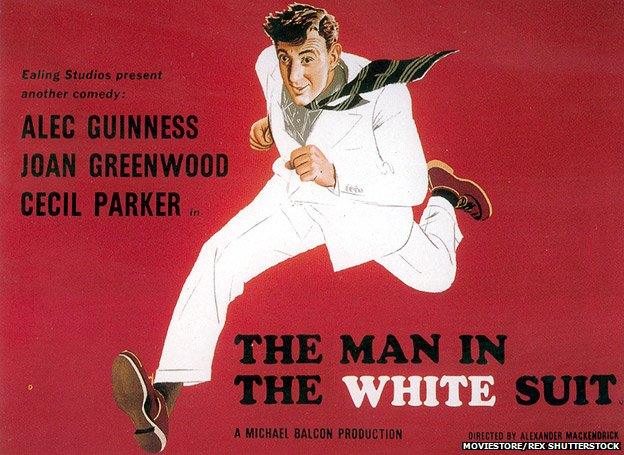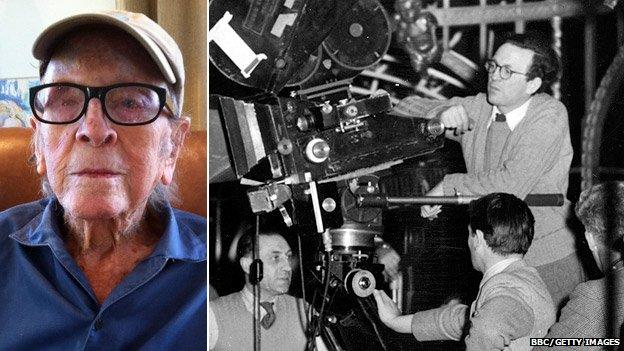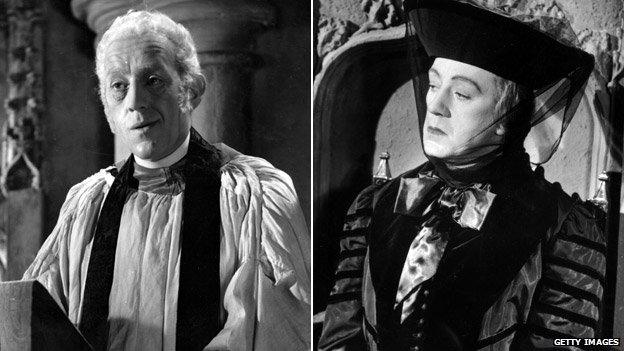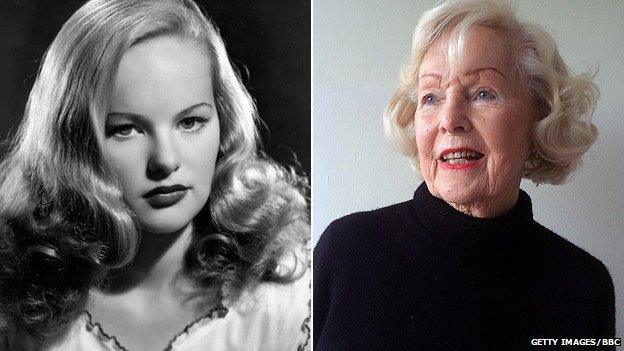Remembering Ealing Studios and the golden age of British film
- Published

Ealing Studios' The Man in the White Suit (1951) was nominated for an Oscar
It is 60 years since the end of the most celebrated era of production at Ealing film studios in London, where classics like The Ladykillers and Kind Hearts and Coronets were shot. Today, just a tiny handful of those involved survive to recall one of the great periods of British film-making.
Cruelly, for one of Britain's most acclaimed cinematographers, Douglas Slocombe is now blind in one eye and has only partial vision in the other.
But when he talks of films he photographed for Ealing Studios, he still smiles at the memory of certain shots - the ripe Technicolor of the romantic Saraband For Dead Lovers or, in Hue and Cry, the beauty of post-war London in black and white.
"If you want to know what London looked like in 1947, with all the bomb-sites, Hue and Cry will tell you," he says. "And when I shot The Lavender Hill Mob four years later, it didn't look that different. Things didn't change then the way they do now."

Douglas Slocombe worked on many of Ealing Studios' classic pictures
At 102, Mr Slocombe may be the last survivor of the top-level team which worked for Ealing's mogul Sir Michael Balcon.
"I think I'm the last man standing. All the major technicians and the producers and directors are gone - and that famous repertory company of actors and actresses. It's a weird feeling to have outlived virtually everyone you ever worked with."
Dougie Slocombe photographed Ealing comedies that are still admired today, such as Kind Hearts and Coronets and The Titfield Thunderbolt. Yet he is equally proud of the serious dramas.
He says a favourite is It Always Rains On Sunday (1947). "There's a dramatic climax we filmed at night in the freezing cold of Temple Mills shunting yard in east London," he recalls.
"The John McCallum character is trying to escape the police and Robert Hamer directed the chase very excitingly. Though it isn't the sort of thing people expect from an Ealing film, you can see the influence of Italian cinema after the war like Rome, Open City.
"And it's a bit more honest about sex than a lot of Ealing films - Mickey Balcon was a fine producer but he could be a bit of a prude."

The Duchess of Cambridge visited the Downton Abbey set at Ealing Studios earlier this year
In 1955, financial pressures meant producer Sir Michael had to sell off the studios. He moved the operation briefly to Borehamwood before finally closing it entirely.
The studios at Ealing were bought by the BBC and in the 1990s were reborn as a facility for hire.
This year they've already played host to the new version of The Dresser with Ian McKellen and Anthony Hopkins and to those parts of Downton Abbey not shot on location. Producer Ben Latham-Jones has recently announced ambitious plans for new Ealing productions.
But anyone who works there today cannot ignore the legacy of the past, says Mark Duguid of the BFI, who worked on a book about the studios.
"Until 1955 Ealing was unusual in being both a working studio and a production company," he says. "In Britain that's generally not been the same thing. The nearest equivalent was probably Hammer, who built Bray Studios in the early 1950s.
"People ask why there's been nothing like the Ealing business model since. I think what they mean is the way the studio came to stand for a certain kind of Britishness.
"In fact over the last 20 years some of the most interesting films from [Notting Hill and Four Weddings and a Funeral producers] Working Title have had something of an Ealing feel. Perhaps owning the bricks and mortar of a studio isn't really that important.

Sir Michael Balcon was not attempting to emulate Hollywood studios
"Michael Balcon's Ealing has been accused of having had a cosy view of what Britain was like, but I don't think that's entirely fair.
"Britain after the war was undergoing real social change. Watch The Man In The White Suit or Kind Hearts And Coronets and you'll find a surprising amount of satire. There's tart social comment beneath all the comedy."
As it happens, both of those films had Dougie Slocombe behind the lens. And in both he worked with Alec Guinness, who stood at the head of the company of actors Ealing liked to employ.
"Alec was usually very quiet. He was dedicated to what he did," Mr Slocombe says.
"I remember him on Kind Hearts sitting patiently on the side of the set and you could forget he was there. But if Alec was playing an unpleasant character he could become difficult off camera; when he was in a genial role he'd be a delight to pass the time of day with.

Sir Alec Guinness played eight roles in Kind Hearts and Coronets
Depending on where you catch Kind Hearts and Coronets, you may discover the alternative ending created for American audiences. A brief extra scene makes clear that Mazzini, now ennobled, is to hang for his crimes. Dougie Slocombe is glad he didn't shoot the second version. "The script was perfect as it was."
He says: "As a rule Michael Balcon was at great pains to ensure Ealing remained very British. There was no point our trying to be MGM and we didn't see a lot of American stars."
There were exceptions, however. To this day people watching The Love Lottery, which Dougie Slocombe shot in colour in 1954, may do a double-take when Humphrey Bogart makes a cameo appearance at the end.

Actress Peggy Cummins says Ealing had a 'more human scale' than Hollywood
The Love Lottery, made late in the Balcon era, starred the glamorous Irish actress Peggy Cummins.
Cummins, 90 this year, does not claim to have been a core Ealing player, in the Guinness mould. "But I did star twice for them so clearly Mickey Balcon felt I was doing something right," she says.
Peggy Cummins had already had a hit in Hollywood with the classic noir Gun Crazy (1950). But she insists filming at Ealing wasn't a step down.
'Shy and formal'
"Not a bit of it. As you walked through the gates you knew the place was compact. But for an actor or actress that isn't important.
"What mattered most was the talent around you. Douglas Slocombe's camerawork on The Love Lottery was equal to anything I saw in America.
"When I was in Hollywood everything was on an industrial scale. That does bring advantages - they pampered you in a way Ealing never could or would. But I enjoyed the more human scale.
"Some of the Hollywood tycoons ruled by fear but it was obvious Mickey Balcon was popular, though he could also be a little shy and formal. Well, he was British - as you might guess from the films he made."

The studio made Scott of the Antarctic in 1948
Douglas Slocombe remembers his sadness when, 60 years ago, it became clear Ealing Studios were to close. "But of course we had to get on with our careers - there was little time for sentiment."
A glance at his credits since 1955 shows he was seldom out of work. Titles range from The Servant to The Italian Job to the first three Indiana Jones films for Steven Spielberg in the 1980s.
Earlier this year he was given a special dinner in London by the Academy of Motion Picture Arts and Sciences, the people who run the Oscars.
"Here we are 60 years after we all walked out of the gates at Ealing for the final time - and still the name means something, not just in Britain. Americans recognise the name too, and people in Europe.
"This small little studio produced something that was completely indigenous. Not everything was a classic, but it had a lasting quality. The best of what we did will be watched and remembered for years to come".